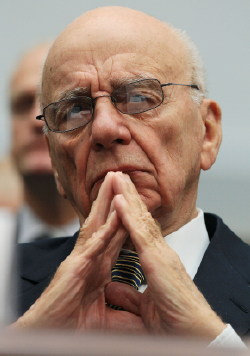
Say what you mean and mean what you say
I don’t know many people who have been gripped by the recent round of political party conferences in the UK. Despite the effort that goes into staging these events and the forensic analysis by commentators, political conferences are generally dismissed as being high on theatre and low on substance. However, I must admit to taking an interest this year from a professional point of view – it is the presentation skills on display at these conferences that fascinates me.
The two main party leaders, Cameron, and Milliband (sorry, I didn’t watch Clegg), have more or less mastered the basics of good presentation skills (no doubt with a lot of help from advisors, trainers and experts in the field). In fact the format and style of their delivery is so similar that there is little to differentiate them. Both speeches were evidently well prepared ; there was a coherent structure which included repetition of the key messages (‘One nation’ for Milliband and ‘Aspiration’ for Cameron). Each speaker included some sort of personal anecdote to show the softer more human side of their character. And both finished with a clear ‘call to action’ to demonstrate inspirational leadership (Milliband: ‘A Britain we rebuild together!’; Cameron: ‘Let’s get out there and do it!”).
Both leaders looked relatively at ease and authoritative. Their speeches were polished and obviously well-rehearsed but, so as not to appear too scripted, were littered with conversational touches. For example both Cameron and Milliband seem to favour “y’know” as a way of showing informality and mateyness.
So Cameron and Milliband both did a thoroughly good job? Well, yes to an extent. But there were two problems for the party leaders.
First, neither appeared to be clear about who their audience was. Ostensibly the speeches were directed at the party faithful in the auditorium waiting to be reassured and inspired to support their leader. But as Radio 4’s Carolyn Quinn said to Michael Gove yesterday ‘at the end of the day, it’s the public’s reaction to (Cameron’s) speech that really matters’. One of the rules of successful presenting is to know your audience and respond to their needs. Unfortunately the party leaders were attempting to speak to two quite different audiences – their party and the electorate. Trying to keep both happy detracts from the overall impact.
And why, despite the polished performances, did these high profile presentations fail to impress the general public? The problem is that politicians are not widely trusted. Both Cameron and Milliband are dealing with an electorate that is losing its respect and confidence in politicians who are known to say one thing and do another. One fantastic speech is not going to change that. Every good leader knows that demonstrating competence, honesty and integrity can only be achieved by your actions over time. Our political leaders have a bit more work to do before what they say can be believed.
Get JPA’s top tips on delivering the perfect presentation here. Top Ten Tips for Presenting
Why diversity targets won’t help the Big Four
The spotlight appears to be on the big four accountancy firms as they struggle to address the lack of diversity in their partnerships. The domination of white men from elite universities continues in these firms with Ernst and Young, for example, reporting that just 17% of its 549 partners are women. Clearly the people occupying senior positions in these companies ought to more closely reflect the diversity of its client organisations and society as a whole – it makes good business sense quite apart from being seen as a progressive and fair employer. Yet the pressure to address current imbalances at the top suggests that some firms are placing more priority on the achievement of diversity targets than on the quality of their partners or the inherent causes of male-dominated workplaces.
Ernst and Young has announced that, within 3 years, at least a tenth of its new partners will be black or from other ethnic minorities. It has also pledged to make at least 30 per cent of its new partner appointments women in the same time frame. Such ambitions might be impressive but are surely misguided. Where are these senior women and ethnic minority partners going to come from? We know that most women entering management roles in the city tend to leave in their thirties or fail to achieve promotion to senior levels. Maternity breaks and child care responsibilities and are part of the explanation for this but there is also evidence that corporate culture discourages women from aspiring to senior management roles. Being a partner means long hours and the high stress involved makes it difficult for women to cope with the demands of work and family. On top of this, the male-dominated, performance-driven culture is off-putting to many highly capable young women.
Any company that is serious about achieving diversity at the top needs a long term talent management strategy. The aim should be to ensure that the firm’s organisational culture and policies reflect a genuine desire to engage, develop, support and promote talent – wherever it comes from. The desire to achieve diversity at senior levels in business should be welcomed, but the problem cannot be resolved overnight. A slavish and superficial focus on targets alone suggests that the top firms are paying lip service to what is a complex and more deep-seated issue.
How to make a million jobs
This week I was delighted to support and sponsor the launch of a provocative and insightful book – “How to make a million jobs” by Colin Crooks. You can order a copy here. Colin is a social entrepreneur who, in his book, challenges all of us to think differently about unemployment and its causes. His solutions are radical but not unrealistic and are based on Colin’s experiences as well as persuasive, independent evidence.
As a leadership specialist, working with corporates, professional associations and universities, it is not immediately clear why I should decide to sponsor such a book.
The main reason is that I share with the book’s author a concern about people and their development. I also believe in the capacity for people to change their attitude and behaviour and to learn new skills.
The book is full of real stories about people, young and old, who had given up all hope of finding work. They were poorly educated, lacked confidence and had few social or employability skills. When these people were offered an opportunity to work and when this was accompanied by some support and encouragement they responded positively. Many went on to better jobs and have not looked back.
The book, and my own experience, demonstrates this: that when people at work are supported and developed in the right way they tend to be good employees. They become committed, engaged, interested and keen to learn. They gain in confidence and in ambition. Of course there are always exceptions. But, in general, we know this simple statement of cause and effect to be true.
The problem is that so many employers do not have the commitment or the capability to provide the support required. The challenge for government, policy makers and anyone with an interest in this area, is to change the attitude of employers. We need to be better at getting employers to truly appreciate and realise the business benefits of developing their people. Then we need employers to be better at motivating, supporting and engaging their staff. Employers should be asking whether they and their managers are managing people effectively and providing good role models to all staff.
The people in Colin’s book were fortunate to be taken on by a good employer with good people management skills. Sadly that’s not true of all employers, and many people entering a new job do not get the support and development they need.
Developing people and changing their behaviour requires patience, and this isn’t easy in the current climate where many companies are driven by an obsession with short term results. But understanding that link: between managing people effectively and building a successful business is fundamental to good leadership. It informs everything I do and it is at the heart of Colin Crooks’ book.
The value of an MBA
There was an interesting discussion on Radio 4 this morning about the value of an MBA and whether MBA study was worth the investment. Josh Kaufman, author of ‘The Personal MBA’ argued that successful businesses are built on a few basic principles and that the greatest entrepreneurs learnt by experience, not in the classroom.
These views – that you can’t teach good leadership and that the MBA has little value – have been around for a long time. Business schools do a good job of defending their position by highlighting the scope and rigour of the MBA and its importance in terms of career progression and earning power. Still the debate rolls on.
It is well known that I have my criticisms of the MBA and have long argued for a fundamental review of the qualification (see my article in the FT on 16 April 2012). However, despite its faults I still believe that MBA study is worth the investment (see my presentation to the City of London Business Library http://www.slideshare.net/jeanettepurcell/10-reasons-why-you-should-get-an-mba-14264411).
So while I welcome the ongoing discussion about the MBA’s future and sympathise with some of the critics of the qualification, I take issue with the argument that is has no value. In particular I do not accept the claim that you only learn how to do business by experience.
First most people’s experiences in business are limited to a single industry, sector and job role. Granted, we learn a great deal from experience, but there is no guarantee that our experiences will cover all aspects of business and management. The MBA fills those gaps in our work experience, giving us access to knowledge and skills that we wouldn’t acquire just by being ‘out there’ in business.
Second, learning by experience is only really effective if we reflect on that experience, analyse it and use it to inform our actions and behaviours in the future. MBA study provides the environment, specialist support and structure for such reflection – encouraging students to share and discuss their experiences so that experience becomes the basis for further learning and improvement.
Let’s have an honest debate about the MBA and its future. But let’s not pretend that experience is all you need in business. It’s the depth of experience and what you do with it that counts.
Why 360 degree feedback works
One of the most valuable attributes a leader or anyone in a management role can have is self awareness. With a deep and accurate understanding of yourself; your strengths, weaknesses, habits and preferences, you have the basis for becoming a great leader. Not only can you make the most of your strengths and address your failings, but you can also build a team around you that fills the gaps in your own skill set. For instance, I am aware of my tendency to get excited about new projects and my desire to get going as soon as the idea finds general support. I tend to overlook the detail at this stage and can overlook potential risks. As a Chief Executive I made sure that my top team included someone I trusted to always consider the detail and to keep my enthusiasm in check if necessary.
But self knowledge can be difficult to acquire – we are often blind to our own personality traits and don’t see what others see in us only too clearly. That’s why it is important to get feedback from people you work with in a carefully managed and anonymous way. I use 360 degree feedback quite regularly with senior managers and teams and I have seen how the results can change behaviour and improve performance. The feedback gives you better self knowledge and shows you how you are perceived by others. Such rich information not only forms a great basis for self development but also provides a tool for measuring improvement (by repeating the same feedback exercise in, say, 6-12 months time).
360 degree feedback involves the identification of a group of people who you work with whose opinions you value and trust. Normally the number of people chosen will be between 6-12. The selected group should include a good cross section of work contacts (for instance a mix of peers, managers, juniors, external clients, board members etc). Ideally you should avoid choosing only the people you like or who you know like you, but you should be confident that the feedback you receive will be constructive and helpful.
The feedback questionnaire can be designed to give general feedback on a number of management issues. Alternatively it can be specific, focused on giving some in depth feedback on an issue where the aim is to build new skills (e.g. effective communication). An independent expert should develop the questionnaire ensuring the questions are valid, clear and fair. All questionnaires are completed anonymously and returned for analysis by the independent expert who then presents the results to the people concerned in a professional and constructive way. Of course, the results might be surprising or even upsetting and so this stage must be handled sensitively. However, it is often the case that people recognise the need for improvement when presented with the evidence. They are also pleasantly surprised at positive feedback which they hadn’t expected.
There are a range of costly and sophisticated business tools used to help improve self knowledge and our understanding of the people we work with. I prefer 360 degree feedback above all of these. It’s simple, relevant and cost effective. Most importantly, it works.
Galloway’s lesson in public speaking
Two male public figures have recently got themselves into trouble for their comments on sensitive issues. First George Galloway, not known for his tact, waded into the Assange affair by introducing the bizarre notion of “sexual etiquette” in the context of rape. At the same time, in the US, Missouri congressman Todd Aiken suggests that there is a special case to be made for ‘legitimate rape’. Both parties (Galloway and Aiken) clearly regret their choice of words and have since been engaged in damage limitation exercises. But the damage is done. In fact the damage gets worse for George Galloway who has just sparked another storm by using a derogatory term for disabled people on Twitter.
I have no intention of getting into the rape debate – that’s not the purpose of this piece. But I think these recent episodes demonstrate the importance of taking some time to think before you speak. Politicians are often caught out when faced with difficult questions without notice. But we are all at risk of humiliation and embarrassment (or worse) now that Twitter, Facebook and social media in general encourages spontaneous communication.
I worked with two senior managers recently who were aiming to improve their ability to present themselves with confidence. They wanted to be able to communicate clearly and fluently, so that they could influence others and gain credibility with peers and clients. Both were enthusiastic, intelligent people with a lot to say. When we first met I asked them to deliver a presentation to me. Both presentations were full of information and moved along at a fast pace. The managers spoke very quickly , sometimes deviating from the topic, sometimes stumbling over words and ultimately failing to get their message across.
When we reviewed their presentations they both admitted to being nervous. “The more nervous I get, the more quickly I speak” said one. “Then as I start to panic, I use all the wrong words and lose my thread entirely – I completely lose my confidence.”
I asked them both to rethink their presentation, paring it down to the most essential points and the key message they want to deliver. Then I asked them to deliver the first five minutes of the presentation to me at a snail’s pace. They had to speak as clearly and as slowly as possible, pausing properly for each comma and full stop. The result was remarkable. Both found that the slower pace gave them time to articulate clearly and to think while they spoke, so that they could anticipate the next sentence and the words they wanted to use. By giving themselves extra time they lost their nerves – and gained control.
Both managers have been practising the ‘slow’ technique regularly and use it when preparing for presentations. Obviously in real situations they speak at a normal pace (which is always going to be a bit faster than it feels) but neither of them rush or gabble as they used to. Neither do they end up getting the words wrong or losing the thread – they now have time to think before they speak.
My first piece of advice to Galloway and Aiken would be to stay away from the topic of rape in the future. But whatever the subject they might also benefit from slowing down a little rather than rushing to an answer. In fact perhaps we could all try a little less spontaneity and a little more reflection before opening our mouths.
Bradley Wiggins – lessons in teamwork
I enjoy a bit of sedentary cycling and have been known to jump on a Boris Bike. But I have never really taken much interest in cycling as a sport. Until now. It has been difficult to escape the excitement surrounding Bradley Wiggins and his Tour de France victory. When I began to understand more about how the race was one I realised that the real story was not so much about Bradley Wiggins but more about Team Sky. We can learn a lot from this extraordinary team and its achievement. And the lessons are just as important to business as they are to sport.
What I hadn’t realised (apologies to cycling enthusiasts who know all this) is that Bradley’s win did not come out of nowhere. It was part of a masterful and finely executed plan in which each member of Team Sky played a crucial part. What is most striking about the story is that any member of the team could (in theory) have been the winner. But the plan was to achieve a win for the team by supporting Bradley’s progress through the course, employing tactics to boost his performance at every stage, thereby ensuring his success overall. In other words the team were united behind a common cause which took precedence over any individual egos and aspirations.
Read any account of Team Sky’s performance and you begin to understand the very specific role that each member played throughout the race. Bradley was the team leader who put in years of relentless hard work and stuck rigidly to his belief in winning. Bradley had to acknowledge his weaknesses (he is apparently not the strongest climber) in order to get support from others in the team where he needed it. Chris Froome, coming second overall, was prepared to stand in if Bradley faltered. He is a better climber than Bradley and could have sought more glory in the race. But that was not part of the plan and so he held back when necessary. Christian Knees, a former champion, stayed at the front during the early stages to control any possible contenders to Bradley. He helped Bradley by keeping him out of the wind for long stretches, allowing him to save his energy for the later crucial stages in the race.
This is impressive team work. The vision to win was truly shared by all; the plan for achieving the goal was meticulously crafted and carefully executed; and everyone involved understood their role in the process. Wouldn’t it be great if more senior management teams followed this example? In business, teams so often fail because individual members struggle to unite behind the common goal. And yet executive teams in particular have a crucial responsibility to the organisation to deliver results collectively. There is no room for personal glory or for defending your own territory regardless of the common cause. Organisations which fail to address the ‘silo’ mentality are highly unlikely to succeed in the long run.
We should of course congratulate Bradley Wiggins for his win. But we should also acknowledge the part each team member played in achieving this victory. Their performance required a level of discipline and self sacrifice that few teams can muster.
Strategy tips for Barclays
With the departure of Bob Diamond as Barclays’ Chief Executive, there is much speculation about the bank’s future strategy and discussion about the strategic options available to Barclays following this week’s dramatic events. This got me thinking about the role of strategic planning in organisations and what makes for a good strategy.
I am continually surprised at the number of organisations I talk to who don’t have a clear strategic plan which informs everything they do. Some will claim to have a plan but, when I question further, it isn’t really being implemented, not everyone knows about it and it doesn’t get reviewed on a regular basis. A well executed strategic plan helps an organisation to know what they are trying to achieve and how they will get there. More than that, it helps everyone in your business to be focused, motivated and efficient.
As a non-Executive Director for a number of charities I am often concerned about the lengthy progress reports received by the Board. These reports provide an update on progress against a long and varied list of activities to develop new ideas or explore opportunities. These charities are not well resourced; staff are stressed and work very hard. The problem is that, in some cases, there is no clear understanding of the overall goal for the organisation, nor is there a well communicated, carefully monitored plan to achieve the goal. No one is really sure about the priorities or the actions that are critical to the organisation’s success.
The liberating part of a good strategic plan is that it helps you to define not only what your organisation must or will do, but also what it will not do. Each potential opportunity or initiative must be evaluated to determine how it will contribute to the overall goal. If it doesn’t clearly contribute to achieving the goal it doesn’t get done. The result is a more effective, motivated organisation that has clarity about what it is trying to do.
I am sure Bob Diamond had a strategic plan for Barclays, whether it was a good plan is another matter. Strategic planning is essential to good business. MBAs are told this and Chief Executives know it. Most of us understand how to formulate a strategy. What doesn’t get talked about so much is the execution of the strategy. How many excellent strategic plans must there be out there which, once written, sit on a shelf gathering dust while life goes on as before? Although the task of developing a good plan is not always easy, the really hard part is engaging staff in its implementation and constantly reinforcing the plan by good communication throughout the organisation. A plan that isn’t understood, supported, rigorously monitored and reviewed simply won’t get done – what a waste of effort!
Top 10 Tips for choosing your MBA
I recently gave a talk for City Business Library, part of the City of London Corporation, on “10 reasons why you should get an MBA”. There was a lot of interest from the audience and a lively debate about issues such as funding, study options and rankings. The questions led to a discussion about how to choose between thousands of business schools, how to get through the admissions process and how to ensure you get the best return on your investment. Here are my top ten tips for choosing the right MBA programme. Follow these steps and you won’t go wrong. Top Ten Tips for Choosing the Right MBA
Murdoch’s latest leadership lesson
Readers of this blog will know about my interest in observing business leaders and drawing lessons from their behaviour. In particular I have been captivated by the Leveson enquiry and what it reveals about the Murdoch way of doing business (see ”Lessons in responsible leadership” 12 July 2011).
Yesterday, during the questioning of James Murdoch, the enquiry demonstrated how carelessly worded private emails can come back to haunt you. Quite apart from what the evidence shows about the unethical (if not illegal) practices taking place, the emails reveal a complete lack of judgement and arrogance amongst News Corp senior executives. They are clearly incapable of behaving ethically, but you might expect senior people to understand the golden rule: Do not commit anything to email that you would not want everyone in the world to read.
And today I have been watching Rupert Murdoch. It is intriguing – he bumbles and pauses and professes to remember very little of past events. One wonders how someone with such a bad memory can have built such a powerful empire. Nevertheless he is bullish and stubborn when he needs to be and has made some astounding statements, for example: ‘I try very hard to set an example of ethical behaviour’. If this is true (OK, just try to imagine for a moment), his influence as a leader clearly counts for nothing within News Corp.
We don’t need the Leveson enquiry to tell us that News Corp is corrupt, that phone hacking took place and that senior people at News Corp are guilty of unethical behaviour. And no one can be surprised to learn that governments are not always impartial in their dealings with big business. What we are learning is that huge corporations are not invincible. Even those at the head of the most powerful organisations are capable of foolish errors, crass behaviour, gross lack of judgement and monumental arrogance.
The leadership lesson? Business leaders who lack authenticity, moral judgement and a genuine sense of responsibility will ultimately fail.



























